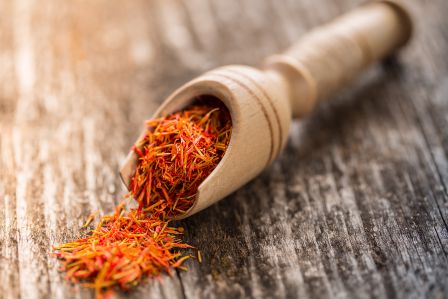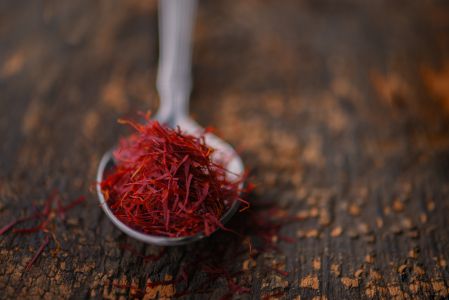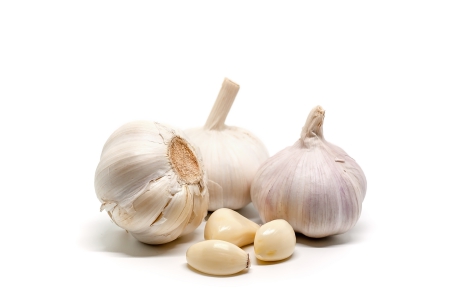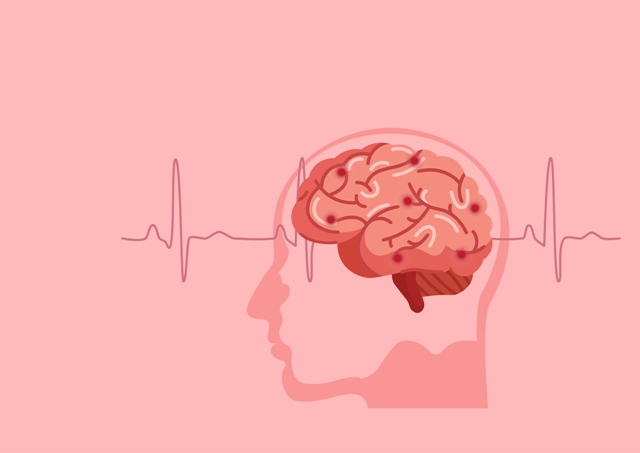Saffron is an important spice derived from Crocus sativus and considered as “the queen of all spices”. It has been traditionally used for centuries for various medicinal purposes and has been extensively used in ayurveda also for treating chronic diseases like arthritis, asthma.
Characteristics
- It is small, perennial and bulbous spice and it is very expensive
- It is deep yellow or orange in color
- It has a floral and sweet taste
- It is generally used to prepare dishes like paella, risotto bouillabaisse and any other rice items
Nutritional profile
- It contains desirable amount of carbohydrates and some dietary fibre
- It contains both saturated and unsaturated fats but free from cholesterol
- It also contains less amount of proteins
- It contains various vitamins such as Vitamin A, Vitamin C, folic acid, niacin, riboflavin and pyridoxine
- It also contains several trace elements like calcium, potassium, selenium, iron, zinc and manganese
- It contains various volatile essential oil that include safranal, pinene, cineole, borneol, phenethenol, limonene, linalool
- It also contains several pigments like carotenoids, α and ß-carotenes, zeaxanthin and lycopene, which are responsible for imparting color and accountable for exerting antioxidant activities
- It contains several important biochemical compounds as well that help to make the saffron more health worthy, which include crocin, picrocrocin, crocetin, gentiobiose, kaempferol

Biological properties
Anti-atherosclerosis activities
- Crocin and crocetin are the principle components of saffron accountable for reducing the prevalence of atherosclerosis
- It has strong anti-thrombotic effects also that helps to prevent clot formation within blood vessels
Anti-inflammatory activities
- It helps to prevent harmful inflammatory events of body
- It helps to prevent inflammation by inhibiting the production of pro-inflammatory cytokines via suppressing NF-κB activity
Antigenotoxic activities
- It has seen that the aqueous extract of saffron has potent antigenotoxic effects
- It helps to protect the genetic material from damages caused by genotoxins (such as aromatic amines, aflatoxin, amides etc.)
Cytotoxic activities
- Safranal and crocin components of saffron are responsible for exerting cytotoxic activity, which is referred to as the superiority of being toxic to cells
- It mainly provides its cytotoxic effects against carcinogenic cells (being toxic against them) and destroys them by interfering with their membrane permeability and by facilitating cellular necrosis
Anti-carcinogenic and antitumor activities
- Carotenoids, picrocrocin, crocin and safranal are responsible for inhibiting the growth of malignant cell as well as tumor cells in body
- It prevents the growth of both malignant and nonmalignant tumor cell by inhibiting their DNA synthesis, RNA transcription and protein synthesis
- It helps to suppress the growth of cancer cells by exerting anti-proliferative effects, by affecting the action of topoisomerase (an enzyme) and by enhancing apoptosis
- It also helps to prevent the genotoxicity of anticancer medicines (these types of medicines often develop secondary malignancy)

Aphrodisiac activities
- Crocin component of saffron has aphrodisiac property that helps to stimulate libido
- It helps to improve sperm motility and morphology
- It also increases sperm count and prevents male infertility
Health benefits
Role on promoting brain health
- Crocin component of saffron plays vital role in preventing mental impairment (age related)
- Antioxidant and anti-inflammatory properties of saffron help to protect the brain from injuries and help to promote the growth and functionality of both central as well as peripheral nervous system
- It helps to improve memory
- It helps to prevent various neurological disorders like Parkinson’s disease, Alzheimer’s disease, memory loss, schizophrenia etc.
- It has seen that consumption of saffron is associated with improving cognition among Alzheimer’s patients


Role on mental health
- It helps to improve mood
- It has seen that saffron extract is beneficial for improving the level of dopamine without affecting the concentration of serotonin in body
- It helps to prevent depression
- It also helps to prevent insomnia
Role on vision
- It helps to protect the eye from free radical damages
- It also helps to prevent age related macular degeneration
Role on immunity
- The carotenoid component of saffron is responsible for improving immunological responses of body
- Vitamin C, Vitamin B complex and phytochemical components of saffron also show immune-modulatory effects
- It helps to prevent the susceptibility of developing infectious disease by acting as an effective immune stimulant
Role on skin
- The antioxidant property of saffron helps to improve the health and tone of skin by providing proper nourishment
- Phenolic compounds of saffron are responsible for protecting the skin from UV ray
- Saffron is associated with promoting skin complexion and helps to whiten the skin
- It also helps to reduce skin pigmentation
- It helps to treat acne
Role on promoting liver health

- It helps to prevent metastasis of liver
- It is associated with reducing the synthesis of reactive oxygen species that prevent oxidative damage of liver
- It improves hepatic functions
Therapeutic activities
Protects heart
- Crocetin component of saffron is responsible for lowering the concentration of LDL, hence reduces the risk of developing atherosclerosis and promotes cardiac health
- Antioxidant activities of saffron help to protect the blood vessels as well as artery from injuries and prevent plaque formation within vessels that promote adequate blood circulation throughout the body
- Anti-inflammatory properties of saffron help to decrease the prevalence of coronary artery disease and reduces cardiac mortality rate
Helps in weight reduction
- It has anti-obesity effect that helps to prevent obesity by increasing the level of leptin hormone, which is related with decreasing fat mass
- It is also related with reducing body mass index (BMI)
- It also has an anorectic effect that is responsible for reducing appetite, which helps to reduce food intake hence calorie consumption
- It is very beneficial for reducing waist circumference
Helps to reduce the prevalence of PMS
- It helps to improve the symptoms of premenstrual syndrome
 Antispasmodic effect of saffron is responsible for preventing spasm and facilitates proper blood flow during menstruation
Antispasmodic effect of saffron is responsible for preventing spasm and facilitates proper blood flow during menstruation- Analgesic effect of saffron also helps to reduce menstrual cramp
It is associated with increasing insulin sensitivity that helps to reduce blood sugar level.
Anti-inflammatory activity of saffron is responsible for reducing the consequences of arthritis.
Antioxidant and anti-inflammatory property of saffron makes it a good wound healer as well. It is mainly beneficial to heal burn injuries.
Recommended dietary allowance
- It has seen that consumption of 30mg of saffron is sufficient to perform all its biological functions within body
- It can be consumed up to 1.5 g per day, which is well tolerated and considered as safe and does not cause any harmful effects
- The upper tolerable unit of saffron intake is considered as 5g per day. Consumption of saffron more than upper limit can cause toxicity within body
Risk factors
- It is better to avoid excessive consumption of saffron (over its upper limit) especially during pregnancy to avoid miscarriages
- In high dose it often causes allergic reaction
- It is also responsible for developing nausea, vomiting, anxiety, drowsiness, headache, diarrhea if consumed in higher amount

Source:
Akaberi, M., Boghrati, Z., Amiri, M.S. and Emami, S.A., 2019. Saffron: The Golden Spice. Science of Spices and Culinary Herbs-Latest Laboratory, Pre-clinical, and Clinical Studies, 1, pp.1-29.
Ghaffari, S. and Roshanravan, N., 2019. Saffron; An updated review on biological properties with special focus on cardiovascular effects. Biomedicine & Pharmacotherapy, 109, pp.21-27.
Kakisis, J.D., 2018. Saffron: From Greek mythology to contemporary anti-atherosclerotic medicine. Atherosclerosis, 268, pp.193-195.
Leone, S., Recinella, L., Chiavaroli, A., Orlando, G., Ferrante, C., Leporini, L., Brunetti, L. and Menghini, L., 2018. Phytotherapic use of the Crocus sativus L.(Saffron) and its potential applications: a brief overview. Phytotherapy Research, 32(12), pp.2364-2375.
Mall, T.P. and Tripathi, S.C., 2017. SAFFRON-A TREASURE OF THE ANCIENT MEDICINE CHEST-AN OVERVIEW.
Namgyal, D. and Sarwat, M., 2020. Saffron as a Neuroprotective Agent. In Saffron (pp. 93-102). Academic Press.
Siddiqui, M.J., Saleh, M.S., Basharuddin, S.N.B., Zamri, S.H.B., bin Mohd Najib, M.H. and bin Che Ibrahim, M.Z., 2018. Saffron (Crocus sativus L.): As an antidepressant. Journal of pharmacy & bioallied sciences, 10(4), p.173.
Yasmin, S., Sethi, J., Nehvi, F.A. and Sharma, E., 2018. Saffron: from medicine to industry.




